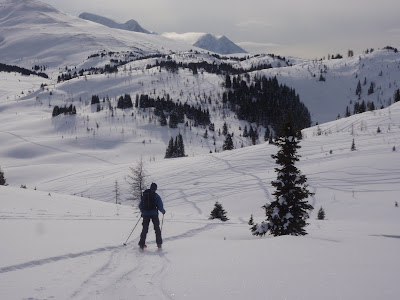 Date: Feb. 8
Date: Feb. 8Mileage: 36
Time: 2 hours, 8 minutes
Weather: 39 degrees, partly cloudy, ESE wind 5-10 mph
Details: Interval training; intensity 60-95 percent
Note: Still lots of ice on the road beyond the shrine.
My future TransRockies partner, Keith, recently started a rigorous training program under the direction of an actual, flesh-and-blood coach. When he asked me if I'd ever consider working with a coach, I said, "No, because eventually the coach would tell me I needed to stay inside on a sunny day, and that would be the end of that."
Not that I'm against coaching in any way. I recognize that if athletes want real results, they need to treat fitness like a science, and that involves doing things they'd rather not do, at times they'd rather not do them. It's just that I have this thing called a "job," which already tells me where I need to be and exactly when to be there, five days a week. I'm not about to take up a second "job" that revolves around bicycle racing and threatens to ruin one of the things in life I truly love - riding bicycles. The day something stops being fun or rewarding is the day I quit, cold turkey. (This ideal has also led me to quit several of my past jobs.)
That said, I am trying to establish a little more of a structured fitness routine under my own rather broad and unscientific terms. Today I planned to do something involving intervals. I had scheduled a trip to the gym, where the handy settings on the elliptical machine help me specifically monitor the time, power output and even heart-rate estimates of each interval. But when I woke up, the sun was trying ever so slyly to peek out of the clouds. Winds were light. Temps were in the high 30s, promising to hit the 40s. Basically, it was April outside. The kind of day where I would definitely tell my imaginary coach to step aside so I could go have some fun.
But I still wanted to do my intervals. I'm not a watch-watcher, so when I'm outside, my interval training is about as unscientific as it comes. Basically, I pick a single song, generally in the two- to three-minute range, with which to ride my intervals. This song is usually from the pop punk days of my youth, which means it's short enough to sprint to, snappy enough to keep the pace, and obnoxious enough that after the third or fourth playing, I am going to purposely enter the pain cave just to block it out. I set my mP3 player so I can sprint to that song, recover to another random song, and then repeat the sprint song. Today I listened to "Cool Kids" by Screeching Weasel.
At first, the interval training went really well. I was sweating and gasping and my heart was pounding into my throat. Then, a pretty song like "All the Trees of the Field Will Clap Their Hands" by Sufjan Stevens would come on and I'd exhale long and slow, shoot a couple of snot rockets, and pedal into the happy daze of post-interval endorphins. Then, like a foghorn out of a thick mist, Screeching Weasel would launch into their namesake rant and "na na na nana nana na nana" - suddenly I was rocketing into clear blue air.
I was supposed to do this for 30 minutes (after a 10-minute warm up) and turn around for a cool-down. But the farther I pedaled north, the more the sky opened up, and the more alive I felt. I felt as awesome as the Cool Kids in the song that wouldn't leave me alone, but rather than become annoyed with the noise, I relished in it, craved it, and pumped harder every time the track started anew. My veins gushed molten lava; my lungs breathed fire and the sun cast a stark shadow directly in front of me. Time seemed to stand still, but what actually happened is nearly an hour passed, and I found myself all the way out at the construction zone near Eagle Beach, feeling fairly exhausted.
Plus, I was 18 miles from home, it was 11:55 a.m., and I really needed to be home by 1 p.m.
Did I mention that I haven't done any speed work all winter long?
The result was I really bonked while I was still a fair distance from home, but I couldn't let off the pace. So I struggled and my head spun and there was no more Screeching Weasel to help me along (I was definitely too annoyed with that song to put up with it at that point.) Sometimes the fog would sink in and I'd find myself limping up the road at about 10 mph, so I'd shake my head around like a driver trying not to fall asleep at the wheel before amping it up again.
Definitely more than a bit too much, too soon. But I have to admit, it was fun while it lasted.
I wonder what my coach would say?
Good thing I don't have one.













































